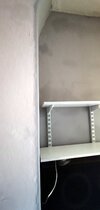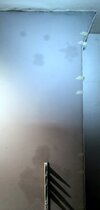I have a spare room with a cold outside wall that has always had condensation hence drips of water. I have hung insulation lining paper with Warlock thermal paste to the left side of the chimney breast. The wall is much warmer. So far so good. I am about to hang it on this side of the chimney breast but there are random damp patches I can't fathom as it isn't condensation (no water run marks). Even stranger are the damp patches on the chimney breast itself which has a gap between it and the outside wall. In fact, the downstairs fire is being used so there is warm air between. The chimney itself was pointed 2 years ago, as well as a new roof. No leaks at all there. and I have storm dried about halfway up the outside of that wall (I need to get higher with some scaffolding to finish) I have also invested in a dehumidifier. I can open the window as much as I can but not in cold weather as I* will lose heat.
So apart from not knowing what is causing these patches, I am hoping that covering the wall with the insulation paper will stop it. I shall try and get higher up (perhaps extended paint roller up a ladder) to finish the storm dry as soon as we get a couple of rain free days as I suspect the odd spayed bricks may be the culprit. The house was built in 1883.
So apart from not knowing what is causing these patches, I am hoping that covering the wall with the insulation paper will stop it. I shall try and get higher up (perhaps extended paint roller up a ladder) to finish the storm dry as soon as we get a couple of rain free days as I suspect the odd spayed bricks may be the culprit. The house was built in 1883.
Attachments
Last edited:



